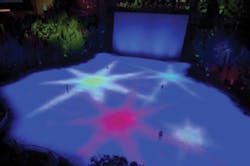Las Vegas hotelier Steve Wynn has a reputation for masterminding big spectacles for his resorts. The Mirage has its 54-foot volcano, and the Bellagio is known for its dancing fountain. So three years ago when he decided that the centerpiece of the Wynn Las Vegas, his new $2.7 billion temple of temptation that opened in April, would be a 20,000-square-foot man-made lake and waterfall that would light up and change colors every 20 minutes, it made sense. For the electrical contractor and systems integrator charged with bringing to life Wynn's Lake of Dreams, though, making sense of the project was anything but easy.
The first step was deciding how to light the lake from beneath the water's surface. Las Vegas-based systems integrator Product Resource Group (PRG) decided early on to use LED fixtures because of their long life, low voltage, and color spectrum capabilities. After running tests in another resort's swimming pool in late 2003 and early 2004 to find a fixture arrangement that would provide an even light distribution, Jim Holladay, a PRG senior project manager, settled on a 2-foot-by-2-foot grid pattern. Of course, that meant donning scuba gear and spending a significant amount of time under water…in February. “I remember looking at the temperature gauge on my diving gear, and it told me the water was 50°F,” Holladay says. “Even in a wet suit, that's cold.”
With the pattern and light spacing finalized, the lake floor was divided into more than 650 4-foot-by-6-foot panels, with six fixtures mounted on each for a total of 4,008 lights. PRG designed an interface that allows the Wynn staff to create patterns for the lights in Photoshop, import them to the control system, and translate the pixel information into the signal for the fixtures. Each fixture represents a pixel on the computer, so they all had to be addressed separately in the control system. All told, it required 25 DMX universes.
Getting those control signals to the fixtures fell to the electrical contractor on the job, Bombard Electric. The manufacturer didn't recommend placing the lights more than 60 feet from a power supply, but because the lake is so large, some of the runs had to be nearly 300 feet long. Las Vegas-based Bombard fed each panel with a multi-cable that carries the low-voltage power conductor and the control signal wiring for the lights. The fixtures' wiring was fed through a hole in the panel to a waterproof junction box mounted on the underside, and a data buffer/amplifier was installed in each box to clean up and boost the signal once it got there.
Although the fixtures had a projected life of 50,000 to 100,000 hours, Bombard had to prepare for the inevitability of general maintenance. And because water is a precious resource in the Nevada desert, they needed to be able to change out dead fixtures without draining the lake, so the contractor mounted the junction boxes at one end of each 6-foot-long panel. Stand the panel on end and the box is above the water's surface, making it easier to access and route in the new fixture's multi-cable. “You pull the fixture off, put a new fixture on, route it through the back of the panel into the box, test it, and set the panel back into the water,” say Rob Berry, a Bombard supervisor who worked on the project. “It's a user-friendly system inside the bottom of the lake.”
Sidebar: Wynn's Tiny Bubbles
Turning a man-made lake into a light canvas isn't as easy as Holladay and Berry make it sound. For the different-colored patterns to be visible, the water had to be translucent. PRG considered rippling the lake (didn't achieve the desired effect) and mixing in a suspension material (the filtration system kept pulling it out), but it settled on injecting air bubbles that would reflect the light. To get even coverage, though, Holladay says they needed to create a flow of 60 cubic feet of air per minute per 100 square feet of water. To do that, they had to install six 400-hp compressors, and there was nothing tiny about them. “They were huge,” Berry says. “Easily the size of an S10 pickup.”
